Overview
Encroachments significantly affect land titles, potentially clouding ownership and complicating real estate transactions. Unauthorized structures can lead to legal disputes and diminished property value. Recognizing and addressing these intrusions is crucial. Proactive measures, such as conducting land surveys and fostering open communication, can help maintain clear title rights. Consequently, these actions avoid costly legal conflicts and ensure the integrity of property ownership.
Introduction
Understanding the nuances of property ownership can be daunting, especially regarding encroachments—those unwelcome intrusions that disrupt the harmony of land boundaries. With nearly 20% of real estate transactions affected by these issues, the implications for land titles are profound. This guide delves into the complexities of encroachments, exploring their various forms and the legal ramifications they entail. What steps can property owners take to safeguard their rights and ensure clear ownership in the face of these challenges?
Define Encroachment and Its Relevance to Land Titles
Encroachment refers to the unauthorized extension of a structure or feature beyond a boundary line into an adjoining area. Common examples include fences, buildings, and trees that intrude into another's land. For real estate experts, it is essential to comprehend how encroachments affect land titles, as these intrusions can significantly impact land rights and the integrity of those titles. Statistics indicate that a substantial portion of real estate transactions—approximately 20%—are influenced by these intrusions, underscoring the necessity for professionals to remain vigilant in recognizing and resolving these matters.
Case studies illustrate that unresolved intrusions can cloud property titles, rendering ownership unclear and potentially diminishing property value. As noted by Deeds.com, "When an intrusion modifies a parcel, a surveyor helps in documenting the exact changes," emphasizing the critical importance of conducting comprehensive land surveys. Furthermore, a prescriptive easement may arise if an intrusion persists over time, typically necessitating a specified number of years as outlined by state and/or local law.
Taking proactive steps, such as maintaining open dialogue with neighbors, can help mitigate the risks associated with intrusions. Ultimately, recognizing how encroachments affect land titles is crucial for ensuring clear ownership and compliance with real estate laws, thereby safeguarding the interests of all parties involved.
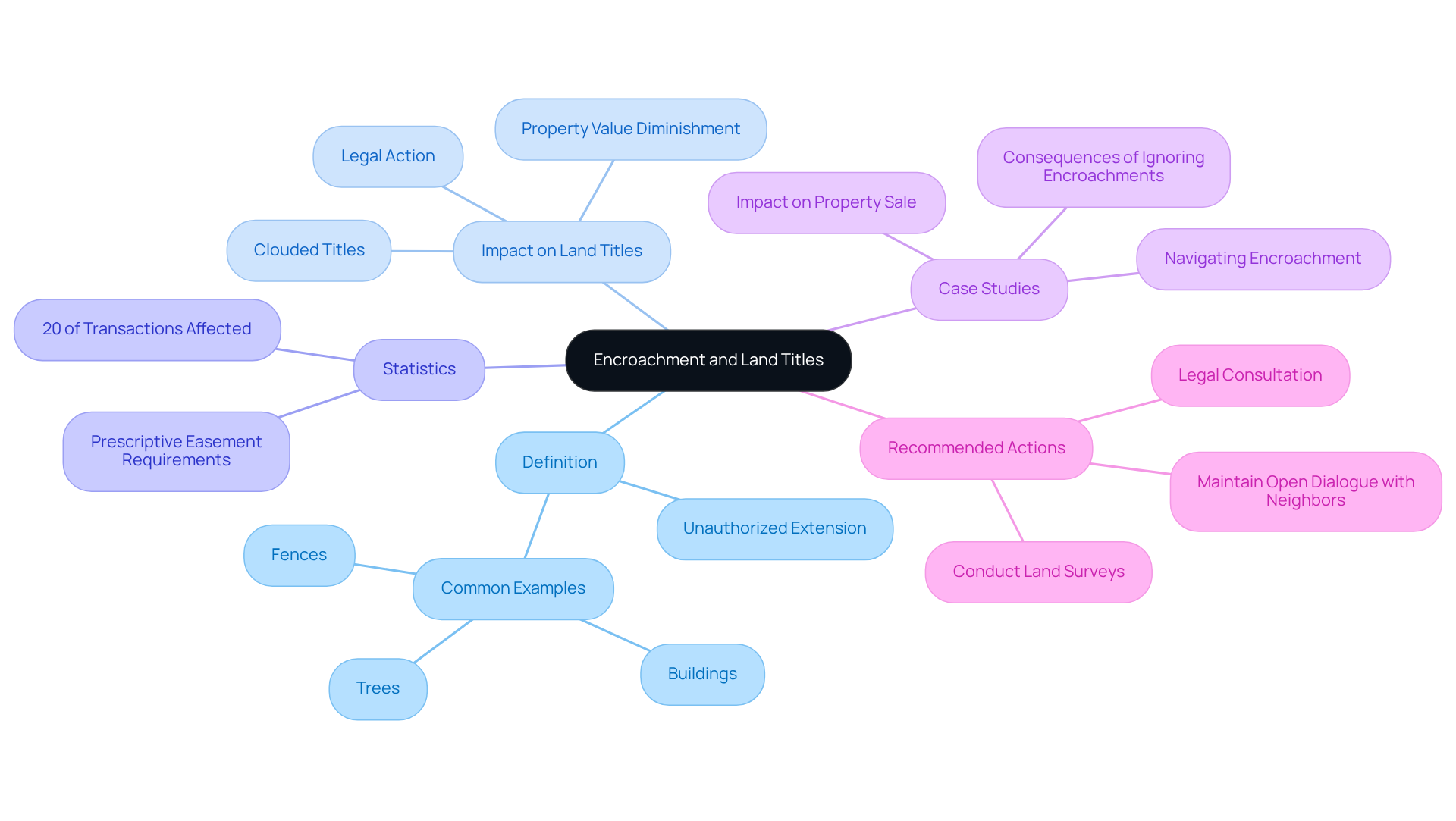
Identify Different Types of Encroachments
Encroachments can be classified into several distinct types, each carrying unique implications for property ownership:
-
Structural Encroachments: These involve physical structures such as fences, walls, or buildings that extend over boundary lines. For instance, a neighbor's fence constructed a few inches onto your land can create complications during real estate transactions, demonstrating how encroachments affect land titles and may necessitate legal resolution. Such encroachments may decrease the final selling price of your home, underscoring the financial implications of these issues.
-
Natural Encroachments: This category encompasses trees or shrubs whose roots or branches extend into an adjacent area. A typical example is a tree in your yard with branches that extend over the fence, potentially resulting in disputes regarding upkeep and responsibility. As noted by experts, 'Though intrusion might seem minor, it can lead to serious issues, including potential liability, property damage, and complications when it comes time to sell.'
-
Temporary Intrusions: Often associated with construction or landscaping activities, these intrusions involve temporary invasions on a neighbor's land, such as scaffolding or equipment placement during renovations. While typically less contentious, they still require communication with neighbors to avoid misunderstandings. Engaging in open dialogue can help mitigate potential conflicts.
-
Adverse Possession: In specific circumstances, prolonged intrusion can result in claims of adverse possession. This legal doctrine permits the encroaching party to gain rights to the disputed land after meeting specific criteria, complicating ownership and title clarity. It is vital for landowners to address intrusions promptly to avoid issues during real estate transactions, particularly concerning how encroachments affect land titles prior to loan finalization.
Recognizing these types of encroachments is crucial for landowners, as it enables them to identify potential issues early and take appropriate action to protect their rights and asset value.
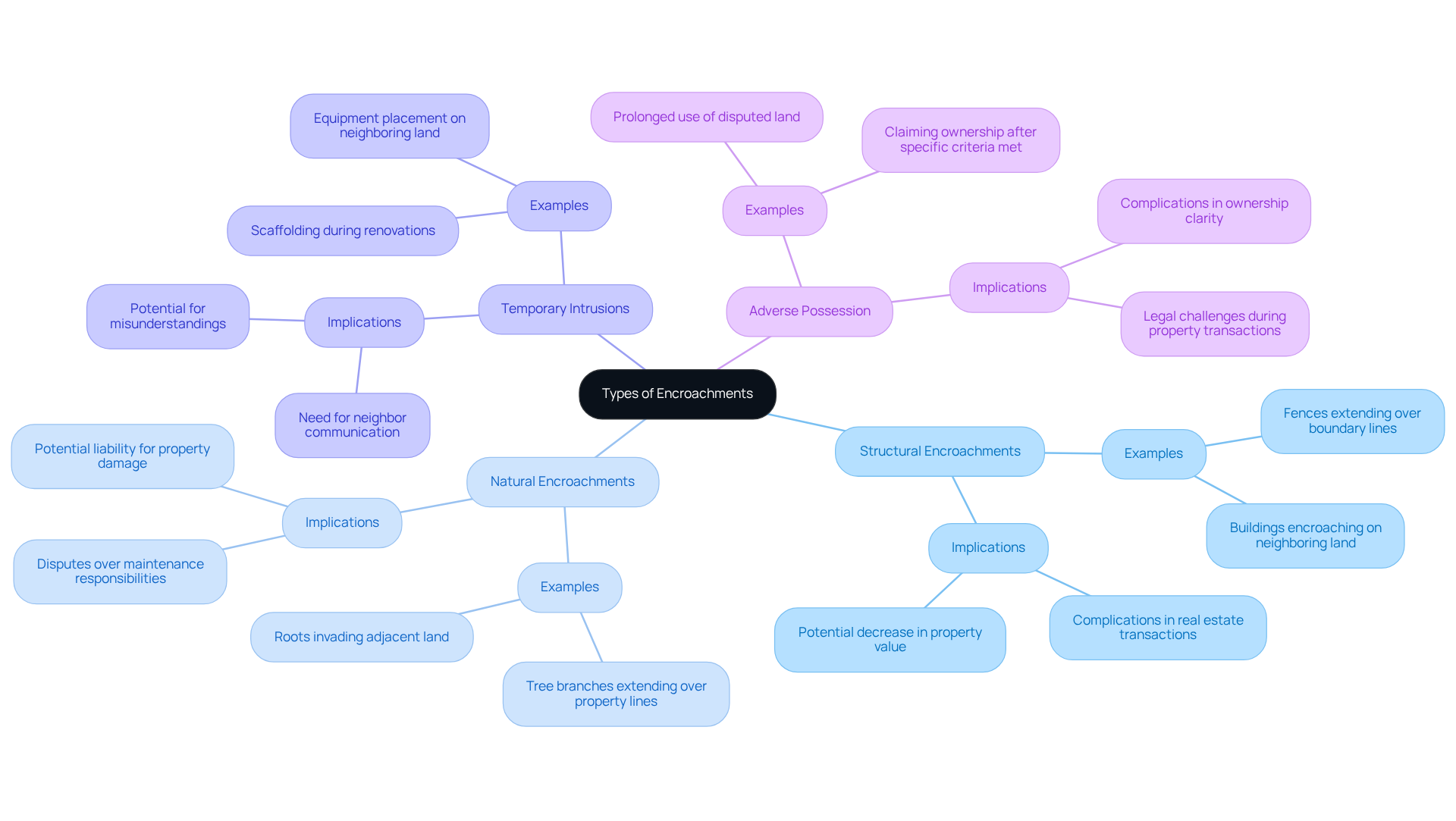
Understand Legal Implications of Encroachments
Encroachments can lead to significant legal implications, including:
-
Title Issues: It is important to understand how encroachments affect land titles, as they often cloud the title of a property, complicating the sale or refinancing process. Title firms usually insist on the resolution of any intrusion before providing insurance, which can postpone transactions and cause uncertainty for purchasers.
-
Judicial Conflicts: Unsettled intrusions often intensify into judicial conflicts. Property owners may pursue lawsuits to seek injunctions for the removal of encroaching structures or to claim damages for any harm caused. Such disputes can be costly and time-consuming, often requiring mediation or court intervention.
-
Adverse Possession Claims: If an intrusion persists for a specified duration, the encroaching party may assert ownership rights through adverse possession. This judicial doctrine can complicate the original owner's rights, potentially resulting in the loss of property if not addressed swiftly.
-
Zoning Violations: Local zoning regulations may be violated by encroachments, resulting in fines or mandates for the removal of the encroaching structure. Property owners must be aware of these regulations to avoid judicial consequences.
For property owners, understanding how encroachments affect land titles is crucial to protect their interests and ensure compliance with property laws. Proactive steps, like acquiring a recent survey and fostering open dialogue with neighbors, can assist in reducing the risks related to intrusions.
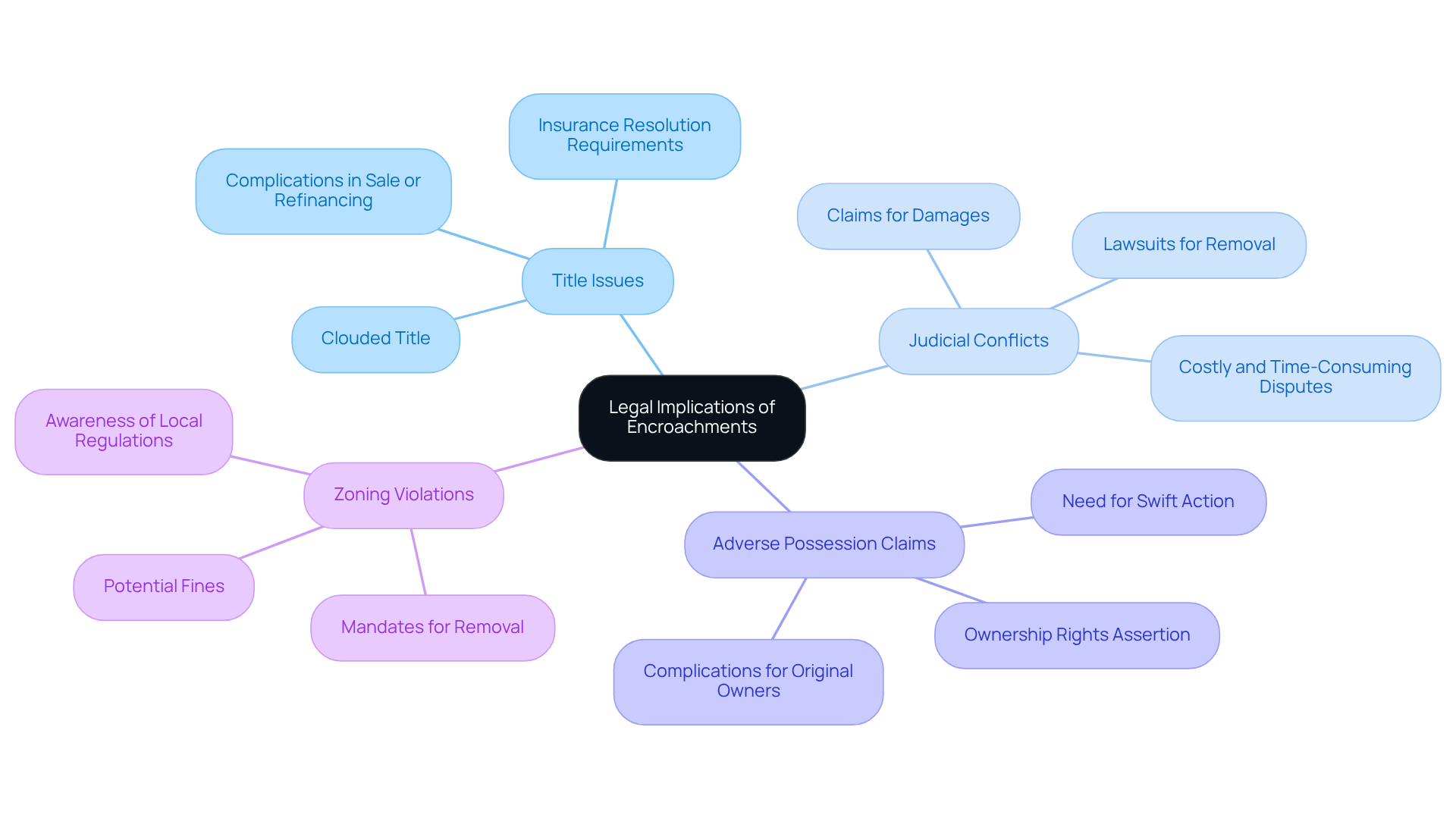
Assess the Impact of Encroachments on Your Land Title
To effectively assess the impact of encroachments on your land title, follow these essential steps:
-
Conduct a Land Survey: Engage a licensed surveyor to accurately ascertain your land boundaries and identify any intrusions. Surveys are crucial, as they can reveal unauthorized structures or extensions that may not be visible at first glance. The average expense for a land survey is around $2,300; however, this investment can prevent considerable legal and financial issues in the future.
-
Review Title Documents: Scrutinize your title insurance policy and land deeds for any mentions of intrusions or easements. Comprehending these documents is essential, as they may hold crucial information concerning your ownership rights and any current agreements that could influence your possession.
-
Evaluate Marketability: Recognize that unresolved intrusions can significantly diminish your property's marketability. Properties with intrusions may discourage prospective buyers, leading to reduced offers or prolonged time on the market. Case studies suggest that residences with intrusions often experience a decline in value, as appraisers may adjust their evaluations based on potential regulatory issues involved. Furthermore, failing to disclose intrusions can result in judicial consequences, making transparency crucial when selling your property.
-
Consult Legal Experts: If violations are detected, it is advisable to consult with a real estate attorney. They can provide guidance on your rights and the best course of action for resolution, whether through negotiation, mediation, or legal proceedings. Legal knowledge is vital, particularly because the statute of limitations for property claims can differ considerably by state, spanning from 3 to 20 years. Mediation or arbitration can also be beneficial in resolving disputes amicably.
By following these steps, landowners can gain a clearer understanding of the consequences of intrusions and take proactive measures to protect their interests. Be aware that minor intrusions, such as overhanging tree branches or small garden elements, can also have an impact and should be addressed promptly.
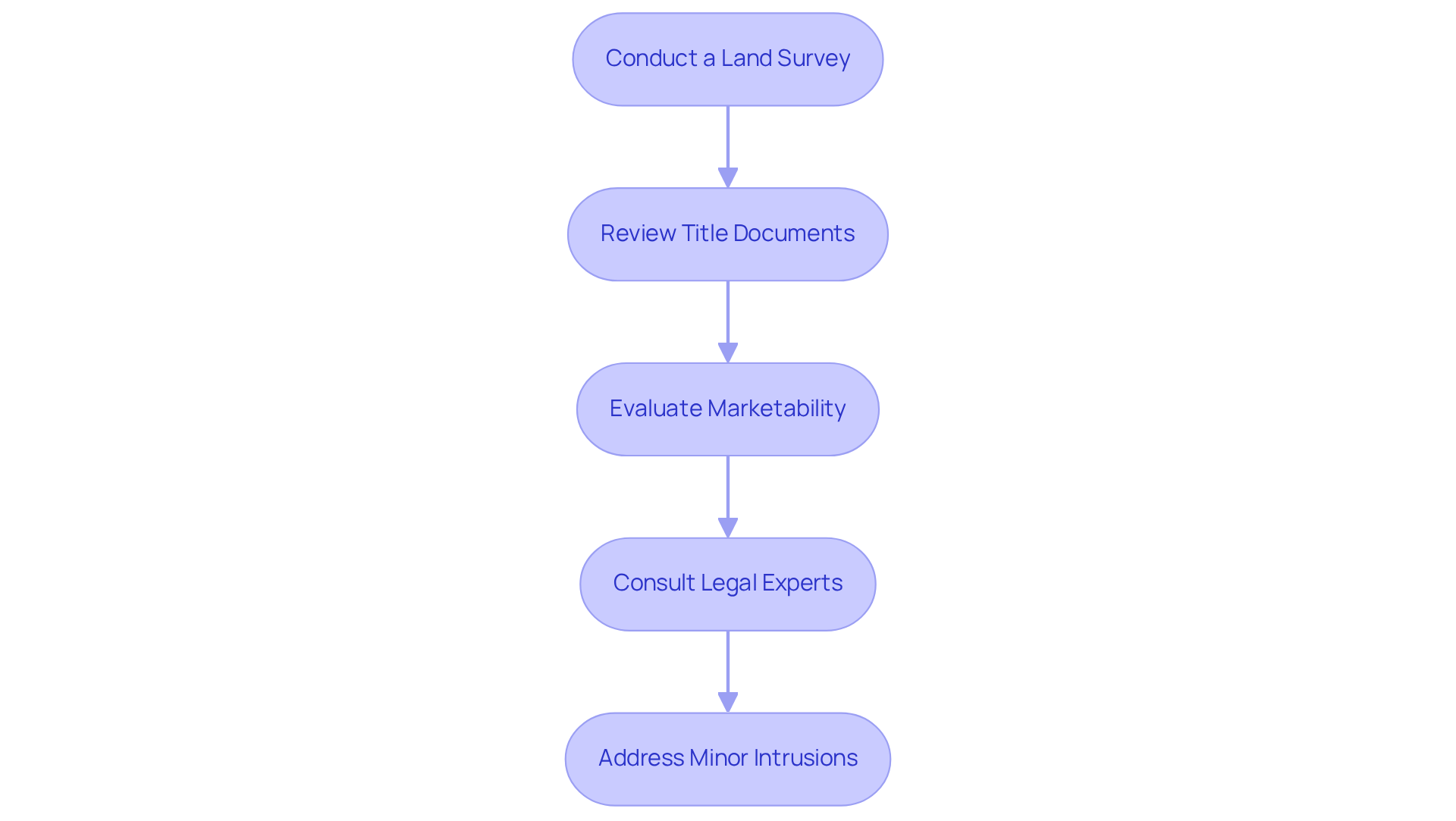
Explore Resolution Strategies for Encroachments
To effectively resolve encroachments, property owners should consider the following strategies:
-
Open Communication: Initiate a dialogue with your neighbor regarding the encroachment. Many disputes can be amicably settled through friendly negotiation and compromise, often proving to be the most efficient approach.
-
Mediation: If direct communication does not yield results, engaging a neutral third-party mediator can facilitate a resolution. Mediation has proven effective in property disputes, as it allows both parties to express their concerns and work towards a mutually agreeable solution. As Nathan Wilkins observes, understanding your rights and seeking expert advice can significantly assist in navigating these disputes.
-
Legal Action: Should mediation fail, legal action may become necessary. Property owners can seek an injunction to eliminate the intrusion or pursue compensation for damages. In Massachusetts, for example, landowners have the option to file a civil lawsuit for encroachments. Consulting with a real estate lawyer is essential to navigate the complexities of real estate law and explore available legal remedies.
-
Easement Agreements: In certain situations, formalizing an easement agreement may prove beneficial. This arrangement allows the encroaching party to maintain their structure while ensuring that your property rights are protected.
-
Document Everything: Maintain meticulous records of all communications and agreements related to the intrusion. This documentation is vital, as it can serve as evidence in any potential legal proceedings. Notably, roughly 9 out of every 10 instances of intrusion remain unreported, underscoring the necessity of proactive documentation.
Statistics indicate that intrusions represent almost 15% of all homeowner conflicts worldwide, with approximately 42% of building code infractions associated with these matters. By proactively addressing how encroachments affect land titles through these strategies, property owners can safeguard their rights and mitigate the risk of prolonged disputes.
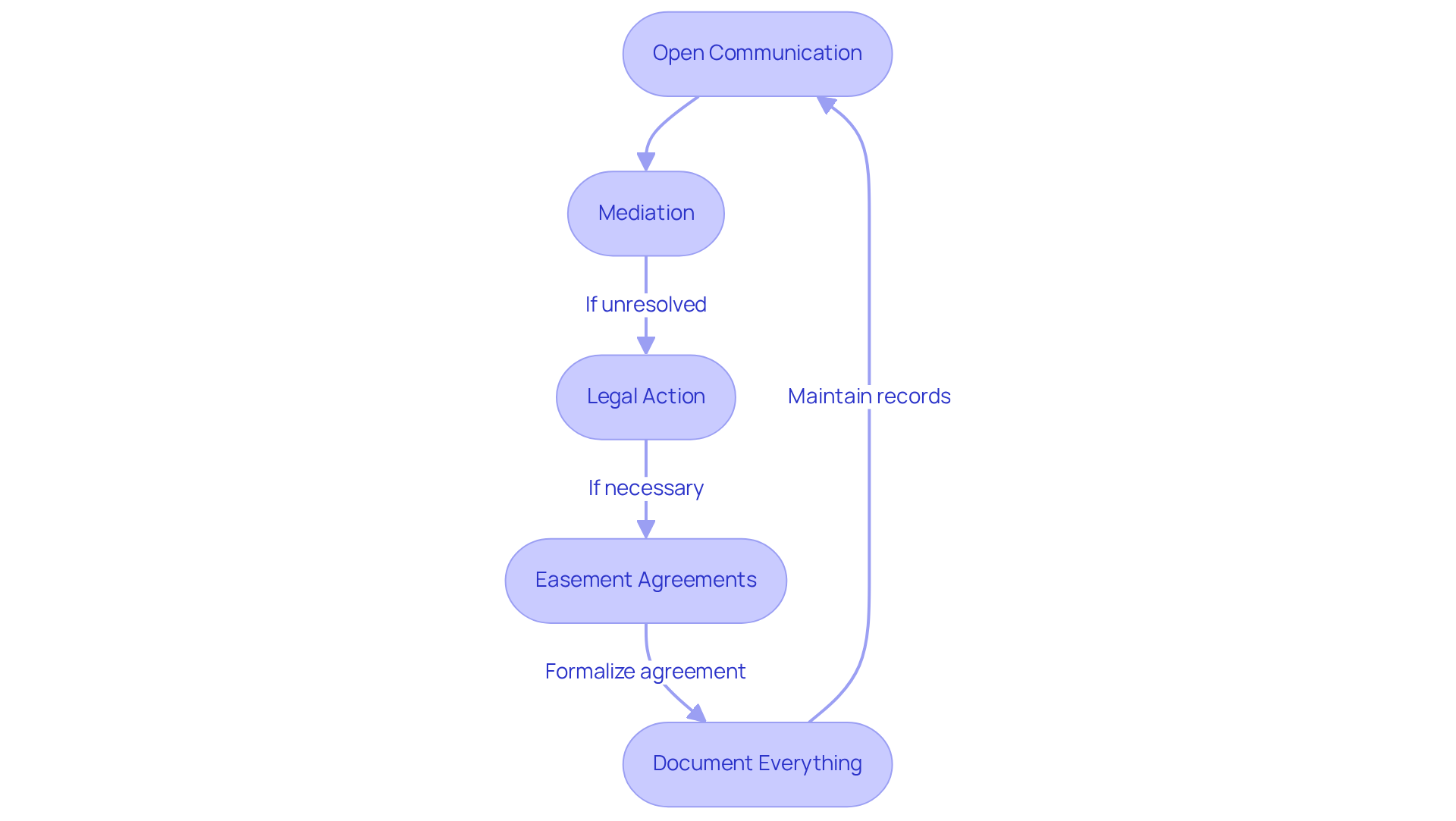
Conclusion
Understanding the impact of encroachments on land titles is essential for property owners and real estate professionals alike. Encroachments—whether structural, natural, or temporary—can lead to significant complications regarding ownership rights and property value. By recognizing the various types of encroachments and their legal implications, individuals can better navigate the complexities of property ownership and ensure their rights are protected.
The article highlights key insights, including:
- The necessity of conducting thorough land surveys
- Maintaining open communication with neighbors
- Understanding the legal frameworks surrounding encroachments
It emphasizes the importance of proactive measures—such as reviewing title documents and consulting legal experts—to mitigate risks and effectively address any potential disputes. The statistics presented reinforce the prevalence of encroachments in real estate transactions and the potential financial consequences for property owners.
Ultimately, addressing encroachments transcends mere property rights protection; it fosters a sense of community and ensures clear ownership. By taking the necessary steps to understand and resolve encroachment issues, property owners can safeguard their investments and maintain harmonious relationships with neighbors. Engaging in proactive dialogue and seeking legal advice when needed can pave the way for effective solutions, ensuring that land titles remain clear and disputes are minimized.
Frequently Asked Questions
What is encroachment in the context of land titles?
Encroachment refers to the unauthorized extension of a structure or feature beyond a boundary line into an adjoining area, such as fences, buildings, or trees that intrude into another's land.
Why is it important for real estate professionals to understand encroachments?
Understanding encroachments is essential for real estate professionals as these intrusions can significantly impact land rights and the integrity of land titles, affecting approximately 20% of real estate transactions.
What are the potential consequences of unresolved encroachments?
Unresolved encroachments can cloud property titles, making ownership unclear and potentially diminishing property value.
What role do surveys play in addressing encroachments?
Surveys are critical in documenting changes caused by intrusions, helping to clarify property boundaries and ownership, as noted by Deeds.com.
What is a prescriptive easement?
A prescriptive easement may arise when an intrusion persists over time, allowing the encroaching party to gain rights to the disputed land after meeting specific criteria as outlined by state or local law.
What are the different types of encroachments?
Encroachments can be classified into several types, including: - Structural Encroachments: Physical structures like fences or buildings that extend over boundary lines. - Natural Encroachments: Trees or shrubs whose roots or branches extend into adjacent areas. - Temporary Intrusions: Short-term invasions, often related to construction or landscaping activities. - Adverse Possession: Prolonged intrusion that can lead to legal claims for ownership of the encroached land.
How can landowners mitigate the risks associated with encroachments?
Landowners can mitigate risks by maintaining open dialogue with neighbors to address potential issues and misunderstandings related to encroachments.




